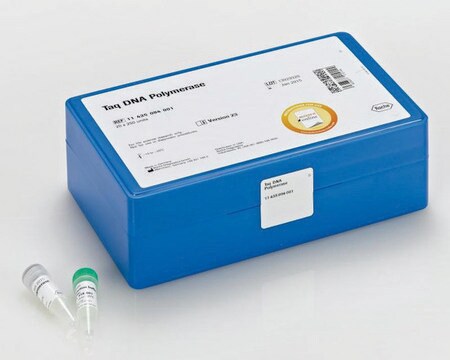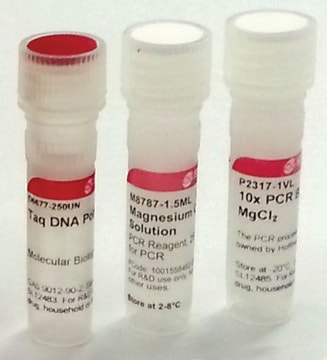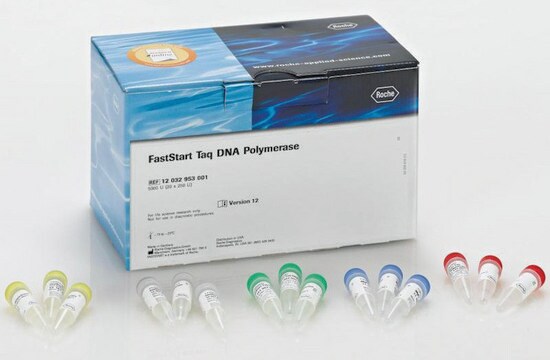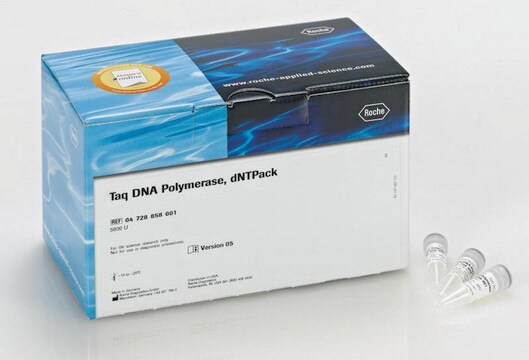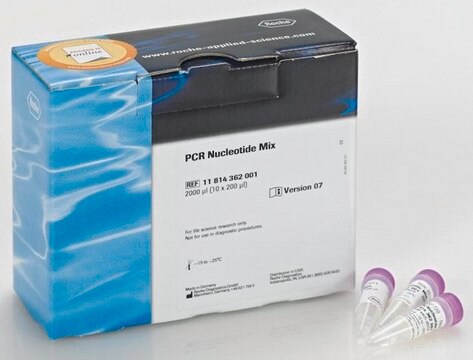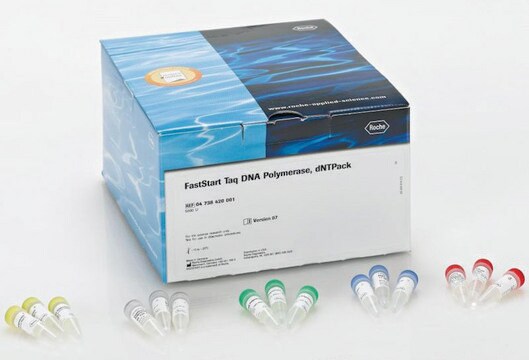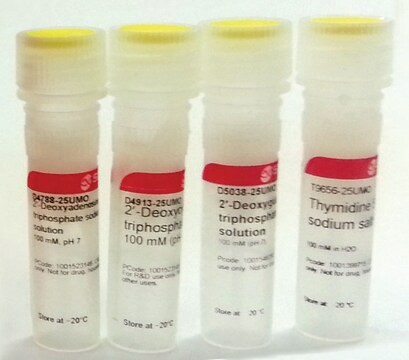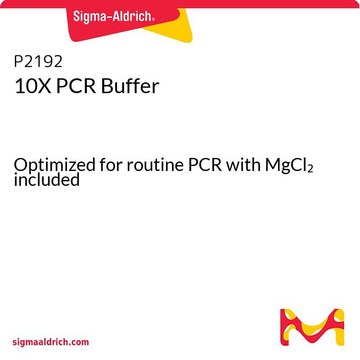TAQL-RO
Roche
Taq DNA Polymerase, 1 U/μl
suitable for PCR, hotstart: no, dNTPs included: no
Synonym(s):
dna amplification, pcr, polymerase, primer extension
About This Item
Recommended Products
biological source
bacterial (Thermus aquaticus BM)
Quality Level
recombinant
expressed in E. coli
form
liquid
usage
sufficient for ≤2,000 reactions (11647687001)
sufficient for ≤500 reactions (11647679001)
specific activity
1 U/μL
mol wt
~95 kDa
feature
dNTPs included: no
hotstart: no
packaging
pkg of 1,000 U (11647687001 [4 x 250 U])
pkg of 250 U (11647679001)
manufacturer/tradename
Roche
concentration
25 U/mL
30 U/mL
parameter
72 °C optimum reaction temp.
technique(s)
PCR: suitable
color
colorless
input
purified DNA
optimum pH
~9.0 (20 °C)
solubility
water: miscible
suitability
suitable for PCR
suitable for molecular biology
NCBI accession no.
UniProt accession no.
application(s)
genomic analysis
life science and biopharma
foreign activity
Endonucleases 20 units, none detected
Nicking activity 20 units, none detected
storage temp.
−20°C
Related Categories
General description
The high processivity, absence of exonuclease activity and temperature optima of Taq DNA Polymerase enable the use of this enzyme in DNA sequencing, especially where the resolution of secondary structures plays a major role.
Application
- PCR
- RT-PCR
- Other primer-extension reactions, such as sequencing and labeling
Packaging
Unit Definition
Unit Assay: Incubation buffer:
67 mM Tris/HCl; pH 8.3/25 °C, 5 mM MgCl2, 10 mM Mercaptoethanol, 0.2% Polydocanol, 0.2 mg/ml Gelatine, 0.2 mM each dATP, dGTP, dTTP and 0.1 mM dCTP.
Incubation procedure:
M13mp9ss, M13 primer (17mer) and 1 μCi (α-32P) dCTP are incubated with suitable dilutions of Taq DNA Polymerase in 50 μl incubation buffer at +65 °C for 60 minutes. The amount of incorporated dNTPs is determined by trichloroacetic acid precipitation.
Volume Activity: 1 U/μl
Other Notes
Legal Information
Kit Components Only
- Taq DNA Polymerase 1 U/μl
- PCR Buffer with MgCl<sub>2</sub> 10x concentrated
- MgCl<sub>2</sub> Stock Solution
- PCR Buffer without MgCl<sub>2</sub>
Hazard Statements
Precautionary Statements
Hazard Classifications
Aquatic Chronic 3
Storage Class Code
12 - Non Combustible Liquids
WGK
WGK 2
Flash Point(F)
does not flash
Flash Point(C)
does not flash
Certificates of Analysis (COA)
Search for Certificates of Analysis (COA) by entering the products Lot/Batch Number. Lot and Batch Numbers can be found on a product’s label following the words ‘Lot’ or ‘Batch’.
Already Own This Product?
Find documentation for the products that you have recently purchased in the Document Library.
Customers Also Viewed
Our team of scientists has experience in all areas of research including Life Science, Material Science, Chemical Synthesis, Chromatography, Analytical and many others.
Contact Technical Service